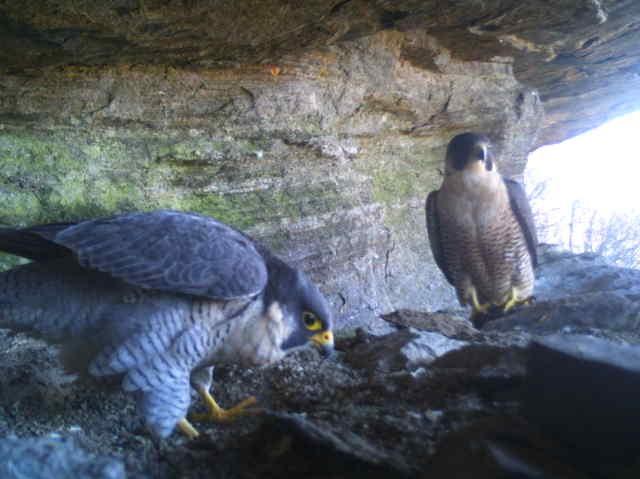
Asheville, NC, March 26, 2024 – The U.S. Forest Service – National Forests in North Carolina and the North Carolina Wildlife Resources Commission (NCWRC) recently announced an order to protect nesting peregrine falcons and their fledgling. The official Forest Order temporarily restricts activities on/near several cliff and rock face areas in the Pisgah and Nantahala National Forests.
The state and federal agencies have been working closely with the Carolina Climbers Coalition (CCC) each year to ensure that peregrine falcon closures balance conservation of the species with access to climbing destinations. This partnership connects agency wildlife specialists and the outdoor recreation community and stands as a shining example of the link between recreation and conservation. Mike Reardon, Executive Director of the CCC says, “This decade-long partnership has resulted in better communication about the need for closure areas and more accurate decisions on closure locations. We’ve worked together to use education and communication as tools for effective recreation management.”
Peregrines, also known as “duck hawks”, were first listed as an endangered species in 1970 due to effects from pollutants such as DDT. While many peregrine populations have recovered from their historic low numbers, disturbance from human activity near nesting sites remains a threat to the falcons in North Carolina. Peregrine mothers must stay with their eggs and nestlings to keep them warm and dry. Male peregrines hunt and deliver a nearly constant supply of food to the nest. Human disturbance, especially a person within eyesight of a nesting location, could result in the parents abandoning a nest or fledglings.
As climbing has grown in popularity nationwide, Pisgah and Nantahala National Forests have become hot spots for the sport. They are known for long, traditional routes in beautiful areas with excellent rock quality. Recreational climbers, outdoor educational programs, military groups and others visit the National Forests in North Carolina daily to enjoy the mental, physical, and social benefits of public climbing access. Climbing as a recreation activity provides regional economic benefits as well, that must be balanced for sustainable forest use.
The climbing route closures give the nesting pair a needed buffer while allowing climbing in other areas. “The closures work,” said Chris Kelly, a Wildlife Diversity Biologist with NCWRC. “Climbers have been involved in self-managing their activities with respect to closures”, says Kelly. “They can easily be reached as a group. We are working together to determine how to communicate better with others who might visit for a short time for drone photos or may be coming out of state to see one of these cliff sites.”
In addition to sharing information, the CCC aided NCWRC biologists in placing and collecting wildlife cameras so they could learn more about peregrine nest failure and success. One nesting site, also known as an eyrie, that failed last year has three new eggs. On the CCC-owned Laurel Knob, biologists confirmed two fledglings last year; the most ever recorded at that location. “We are so grateful to the climbing and recreation community for their support in protecting this amazing species. It’s a great outcome when we can work together to manage all of the special resources on our Forests – for the humans and the wildlife that love it,” said Jenifer Bunty, U.S. Forest Service Public Affairs Specialist.
To learn more about climbing closures throughout the Carolinas, visit:
https://www.carolinaclimbers.org/content/peregrine-closures-2024.html.To learn more about the NC Wildlife Resource Commission, visit https://www.ncwildlife.org.
For more information, visit www.fs.usda.gov/nfsnc or follow the National Forests in North Carolina on Facebook (www.facebook.com/nfsnc).
















